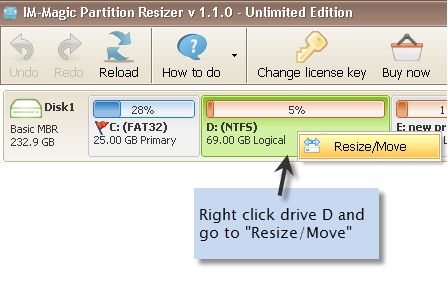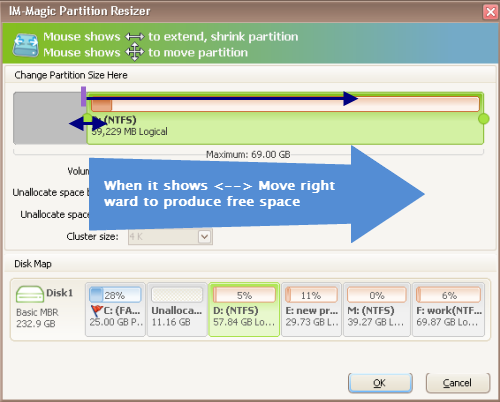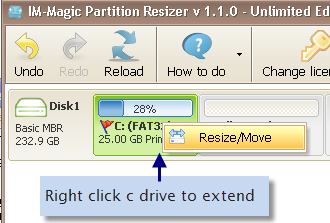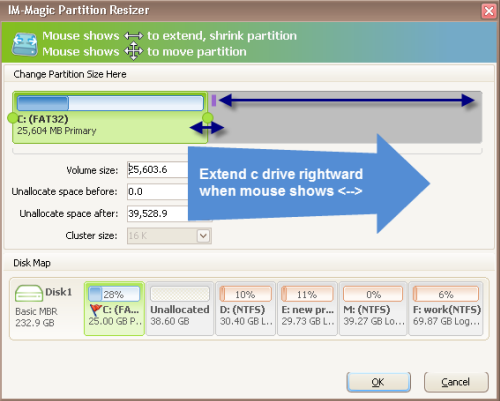Windows Server 2003 R2 is the update
version of Windows 2003. Although Windows 2003 R2 has some improvements compared
with Windows 2003, the only Windows built-in tool that can extend
disk volume in Windows 2003 R2 is Diskpart command. However, Diskpart command
in Windows 2003 R2 only enables you to extend a NTFS data volume. In another
word, you cannot extend an FAT32 partition and you cannot extend
a system partition by using Diskpart command. In this situation, you will
need to rely on other method to extend system partition on Windows Server 2003
R2.
Partition Software for System Partition Extending on
Windows 2003 R2
Partition software is specially designed
for disk volume resizing on Windows Server. With the partition software, you
can extend system partition on Windows 2003, Windows 2003 R2, and other Windows
Servers. It can resize
hard disk on Windows Server without repartitioning the disk. When system
partition is running out of disk space, the partition software can help
increase the partition size without formatting. As long as there is unallocated
space, the partition software can meet all needs to resize the system partition
on Windows Server 2003 R2. Even if there is no unallocated space, this
partition software can shrink other partitions to generate some unallocated
space so that you can extend the system partition.
Steps to Extend System Partition on Windows 2003 R2
Step1. Download, install and launch the
partition software. Then, you need to right click a partition that has enough
free space and go to "Resize/Move" option.


Step2. You can move arrows when mouse shows
double arrows symbol, and then you can produce some unallocated space.


Step3. Move the unallocated space close to
system partition. Then, right click system partition and select "Resize/Move"
option.


Step4. When mouse shows double arrows
symbol, you can move the arrows so as to add the unallocated space to system
partition. Then, click "Apply" button to apply all pending
operations.

Extend System Partition Windows 2003 R2 VMware
Partition software provides easy solution
for Windows Server 2003 R2 system partition resizing. What is more, the
partition software also supports to extend
system partition in VMware on Windows Server 2003 R2. As a matter of fact,
the partition software has the function of extending C drive system partition
boot partition primary partition on all Windows Server OS. To extend system
partition in VMware, unallocated space is also needed. Therefore, you need to
ensure that there is enough free space on the VMware disk before you can extend
the system partition on Windows Server 2003 R2.
Expand System Partition on RAID 5 in Windows 2003 R2
When system partition is running out of
disk space on RAID 5 on Windows 2003 R2, partition software is also available
for RAID 5 disk resizing. Therefore, you can run the software to expand the
size of system partition by moving free space from other partitions on the RAID
5. If there is no enough available space on RAID 5, you can add another disk to
increase the size of RAID 5 and then extend the system partition. The partition
software can extend
the disk partition on Windows Server 2003 without touching any data stored
on the disk, so you can completely rely on it. If you need to resize system
partition on RAID 5, you should remember not to delete the RAID 5 array before
resizing the disk partition.
Why Select Partition Software
1.
The partition software enables you to extend system partition in all situations
You can extend system partition when it is
running out of disk space
You can extend the system partition whether
it is NTFS or FAT32 file system
You can extend
the system partition on all Windows Server operating systems
2. Partition
software allows you to extend system partition without reinstalling rebooting
By using this partition software, you can
resize system partition C drive without reinstalling which helps you save lots
of time and makes the partition resizing easy. With this software, you can
resize all brands of hard disk without rebooting your computer.
Related Articles

No comments:
Post a Comment